Almost
Doing
Wrong
Introduction
Right / Wrong, it feels like it refers to everything and nothing. Beyond
this simple duality, what is continually asked is what we can do and
what we can’t do. When we need to get things done, we ’re trying to get
the right answer or do the right thing, we’re trying very hard to stay
on the straight path. Any time, we avoid unwanted turns that seems
irrelevant and doubtful. But at some point, we have to wonder if the
thing we’re pushing away isn’t more than just annoyance or inefficiency.
Something more subtle may happened as well.
Why is it worth paying attention to wrongness ?
Any goal always involves some decision-making under uncertainty. This means the opportunity to carve out hidden and special zones. Vanishingly rare things are mysterious and surprising. In this case, it turns out that nothing is more useful than the useless: unpredictability, mistakes, accidents, errors, failures.
The dark vastness of possibility is not the opposite of rightness so much as its turned echo. Almost doing wrong welcomes this ambiguity by looking at exceptions-to-the-rule and special cases. A place whereby making decisions can be simultaneously right and wrong. Instead of questioning rightness itself, it is important to first grasp wrongness as the breaking point of what feels right.
Why is it worth paying attention to wrongness ?
Any goal always involves some decision-making under uncertainty. This means the opportunity to carve out hidden and special zones. Vanishingly rare things are mysterious and surprising. In this case, it turns out that nothing is more useful than the useless: unpredictability, mistakes, accidents, errors, failures.
The dark vastness of possibility is not the opposite of rightness so much as its turned echo. Almost doing wrong welcomes this ambiguity by looking at exceptions-to-the-rule and special cases. A place whereby making decisions can be simultaneously right and wrong. Instead of questioning rightness itself, it is important to first grasp wrongness as the breaking point of what feels right.
Boredom
Daily, all through our thinking, we’re trying to keep our mind busy,
endlessly shifting forces between lack and excessive thoughts. To make
sense of our life is like seeking problems when there is none. However,
how can we go much further if we don’t encounter a problem? Habits are a
comfort and it’s good, but at some point, it resonates with meaningless
routines. Doing something again and again could become boring and
automatic. To resist boredom, we feel the urge to discover other paths,
even if it brings complication. As the mind asks for continual change,
we explore the thread that connects discoveries and habits.
“ Gaps and lacks…is the highest and deepest knowledge of human nature,
through which we must climb our way up to the ideal- ideas and doubts-
the summum bonum of our reason. ”
Johann Georg Hamann, Writings on Philosophy and Language, 2012
(Cambridge: Cambridge University Press).
Anne Friedberg, in her essay,
Les flâneurs du mal: Cinema and the postmodern Condition defines the shopping mall as an ‘Activity center’. It’s a gathering of
most common stores, restaurants and services joined into one huge space.
This public space changes the purpose to just go shopping. Shoppers
visit a mall not only for shopping but also for all types of different
activities. The accumulation of services and goods, all in one shopping
mall provides plenty of choices at one’s fingertips. As we take a walk
into a shopping mall, we circulate through elevators and stairs,
switching floors and likely strolling along passageways. The shopper is
tent to stop as the shop window drives him to enter. Entering the shop;
interior furnishings, layout, lighting, music and atmosphere, nothing is
left to chance.
“ Ultimately the aims of contemporary architecture and the police
converge most strikingly around the problem of crowd control…the
designers of malls and pseudo-public space attack the crowd by
homogenizing it. They enclose the mass that remains, directing its
circulation with behaviorist ferocity. ”
City of Quartz: Excavating the Future in Los Angeles, Mike Davis, 1990
Containing their own climate within, enabling the streets to be
enclosed, shopping centers recreate the experience of the city, out of
any perturbation. The mall creates the illusion of the outdoor, greenery
landscapes with trees and large plants, sometimes in plastic. Indeed,
the shopping mall is designed to find solutions against accident and
noises of the city such as beggars, traffics sounds, weather changes…
The will to be free of unwanted disturbances manifests how the shopping
mall is a shield against complications.
All-in-one space, to suggest our way to behave and the need to control the surrounding; the purpose of the shopping mall certainly is to frame what we need. Isn’t it what we search into habits and familiarities? To gain control over our lives? Habits need to be hermetic to change in order to be efficient. When we separate daily task from complications, the result is an empty action, an automatism. An automatism is a instrument to sustain daily life. An automatism is linked with learning, it builds progressively a skill as it prevents to start all over again from zero. We learn how to read until we no longer realize that we are reading.
Nonetheless, as habits sustain life as possible, they can also undermine it. These two seemingly opposed tendencies, enhancing and diminishing, finds an analog in Plato’s Phaedrus. The Egyptian god of writing, Thoth, offers King Thamus writing as a remedy (“ Pharmakon”) that can help memory. King Thamus refuses the gift on the grounds that it will only create forgetfulness. It is not a remedy for memory itself but a way of diminushing remiding things. Writing is thus a poison (“ Pharmakon”).
The fact we still call the pharmacy drugstore in Anglo-Saxon countries shows the ambiguity. This type of ambiguity is also noticeable, in the case of the word gift, which means gift in English and poison in German. It seems difficult to resist the tendency to develop a poisoned gift notion to denunciate anything that suffers of ambivalence.
With digital technologies growing, we leave worries, little by little, to the machine. Phones are full of apps applied to make our life much easier. Through phones, we can check the weather, stay update, pay rent, being reachable everywhere…No doubt there are enormous benefits. Technologies are increasingly structured to make us stabilize into a routine, everything can be done as quick as possible and it improves our life.
Although technology might be a useful tool, it can be a poisoned gift too. Encouraged by its constant usage, technology can have side effects and could lead to an excess of guidance, an impossibility to change, the automation of the will. When you always make one decision and stick with it, you have only one choice, and that makes you unfree. Technology is an automate decision-making which holds down the downsides of accidents. In this case, Accidents are seen as superfluous, just a waste of time. But every discovery comes with its own unforeseen problems. It’s nice to not know what to expect.
All-in-one space, to suggest our way to behave and the need to control the surrounding; the purpose of the shopping mall certainly is to frame what we need. Isn’t it what we search into habits and familiarities? To gain control over our lives? Habits need to be hermetic to change in order to be efficient. When we separate daily task from complications, the result is an empty action, an automatism. An automatism is a instrument to sustain daily life. An automatism is linked with learning, it builds progressively a skill as it prevents to start all over again from zero. We learn how to read until we no longer realize that we are reading.
Nonetheless, as habits sustain life as possible, they can also undermine it. These two seemingly opposed tendencies, enhancing and diminishing, finds an analog in Plato’s Phaedrus. The Egyptian god of writing, Thoth, offers King Thamus writing as a remedy (“ Pharmakon”) that can help memory. King Thamus refuses the gift on the grounds that it will only create forgetfulness. It is not a remedy for memory itself but a way of diminushing remiding things. Writing is thus a poison (“ Pharmakon”).
The fact we still call the pharmacy drugstore in Anglo-Saxon countries shows the ambiguity. This type of ambiguity is also noticeable, in the case of the word gift, which means gift in English and poison in German. It seems difficult to resist the tendency to develop a poisoned gift notion to denunciate anything that suffers of ambivalence.
With digital technologies growing, we leave worries, little by little, to the machine. Phones are full of apps applied to make our life much easier. Through phones, we can check the weather, stay update, pay rent, being reachable everywhere…No doubt there are enormous benefits. Technologies are increasingly structured to make us stabilize into a routine, everything can be done as quick as possible and it improves our life.
Although technology might be a useful tool, it can be a poisoned gift too. Encouraged by its constant usage, technology can have side effects and could lead to an excess of guidance, an impossibility to change, the automation of the will. When you always make one decision and stick with it, you have only one choice, and that makes you unfree. Technology is an automate decision-making which holds down the downsides of accidents. In this case, Accidents are seen as superfluous, just a waste of time. But every discovery comes with its own unforeseen problems. It’s nice to not know what to expect.
Hi stink
Stijn
Autocorrect Fails are funny when something wrong is still okay
because you didn’t purposely make the mistake. You could not predict it
nor avoid it. Humor arises when something is wrong yet okay, threatening
yet safe.
What’s happening when the technology goes wrong ?
Taking example of the autocorrect. If the purpose is to correct words, this software need to have some definition of correctness. But autocorrect efficiency has its limits. When sometimes fails, it reminds us how playful it is to deviate from the right path. Autocorrect is a cross over between gaining and losing. Sometimes we need a de-automation to have a good laugh.
When things goes wrong, it produces an indifference. It shows a detached attitude towards what is correct. Boredom does not imply that we should do away with all habits, but that we should recognize their limitations. Habits can be precious, or not. It could lead to a spontaneous expression, or it can be just a phony orchestrated behavior.
What’s happening when the technology goes wrong ?
Taking example of the autocorrect. If the purpose is to correct words, this software need to have some definition of correctness. But autocorrect efficiency has its limits. When sometimes fails, it reminds us how playful it is to deviate from the right path. Autocorrect is a cross over between gaining and losing. Sometimes we need a de-automation to have a good laugh.
When things goes wrong, it produces an indifference. It shows a detached attitude towards what is correct. Boredom does not imply that we should do away with all habits, but that we should recognize their limitations. Habits can be precious, or not. It could lead to a spontaneous expression, or it can be just a phony orchestrated behavior.
Complex /Simple
Generally speaking, simplicity is good and complexity is bad. The way
which we value things depends on what we compare them to. Simplicity is
with no doubt something to strive for. It gives clarity. Simplicity is
highly valorized compared to complexity.
In the mind, there is a lot of everything and everything seems to be on the same level. It is a lack of certainty, nothing is clear. This chaos is complexity. In order to manage this chaos, we make things simple. We shape things that are far more subtle and complex in reality. To simplify is to make a bizarre selection among others.
In the mind, there is a lot of everything and everything seems to be on the same level. It is a lack of certainty, nothing is clear. This chaos is complexity. In order to manage this chaos, we make things simple. We shape things that are far more subtle and complex in reality. To simplify is to make a bizarre selection among others.
“ I became obsessed by the idea that something outside your body has the
power to make you think of something specific. If, for example, there
are five cubes of sugar outside your body and you see them, your mind
forms the number five.”
Marc Manders, The absence of Marc Manders, 2005
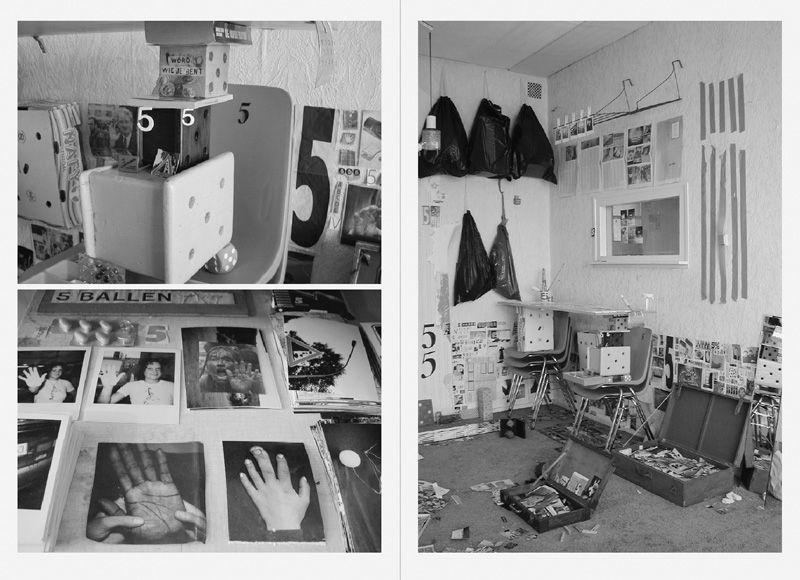
Marc Manders, The absence of Marc Manders, 2005
The installation of Mark Sanders,Room with Fives , is a room
filled with small variations of the number five. As the installation
repeats the number five, those different objects show a constant motion
of forms, shifting from one state of five to the next. Without a clear
beginning nor end, the five becomes more complicated: cards, chairs,
pictures, hands, papers, lines, points… Five could be anything.
With five as the rule, every object is shaped and connected with one another. What the rule establishes is limitations. The rule is the fact that you need five times: five sugars, five points, five lines, five fingers, five pills, the number five, the word five… etc.
The rule (here the five) sounds like it means several things:
- It’s aimed at representing something.
- Every object you encounter maintains the production of difference, but this does not preclude to think all objects look alike.
- Each object is never enough to stop thinking about what could represent the rule.
Our mind stops and make us think something like “this is it”. But reality catches up too fast, and make appears something new again. New, another way to say it means infinite specifications.
With five as the rule, every object is shaped and connected with one another. What the rule establishes is limitations. The rule is the fact that you need five times: five sugars, five points, five lines, five fingers, five pills, the number five, the word five… etc.
The rule (here the five) sounds like it means several things:
- It’s aimed at representing something.
- Every object you encounter maintains the production of difference, but this does not preclude to think all objects look alike.
- Each object is never enough to stop thinking about what could represent the rule.
Our mind stops and make us think something like “this is it”. But reality catches up too fast, and make appears something new again. New, another way to say it means infinite specifications.
“It is only qualitative changes of state, differentiations, that can
account for the appearance of the new.”
Henri Bergson
Radical Simplicity
The rise of modernism at the beginning of twentieth century is
characterized by its reaction to the emerging Industrial Age. The basic
foundation of modernity was said to create an experience that cut across
all boundaries, re-investing universal themes and trying to escape
traditional approach. Le Corbusier’s inspiration compelled him to found
a timeless architecture.
Le Corbusier believed that the solution for social structures lies in mathematical ordering of the built environment. Le Corbusier has attempted to break with traditions and bypass old-thinking through means of going back to first principles. The modern style took a shifting turn to start from zero by the use of geometric shapes. Solutions were found proposing pure forms: minimal ornamentation, repetitive components, and high-rise construction.
Le Corbusier believed that the solution for social structures lies in mathematical ordering of the built environment. Le Corbusier has attempted to break with traditions and bypass old-thinking through means of going back to first principles. The modern style took a shifting turn to start from zero by the use of geometric shapes. Solutions were found proposing pure forms: minimal ornamentation, repetitive components, and high-rise construction.
“ We strive for order, which can be achieved only by appealing to what
is the fundamental basis on which our minds can work: geometry. ”
Le Corbusier
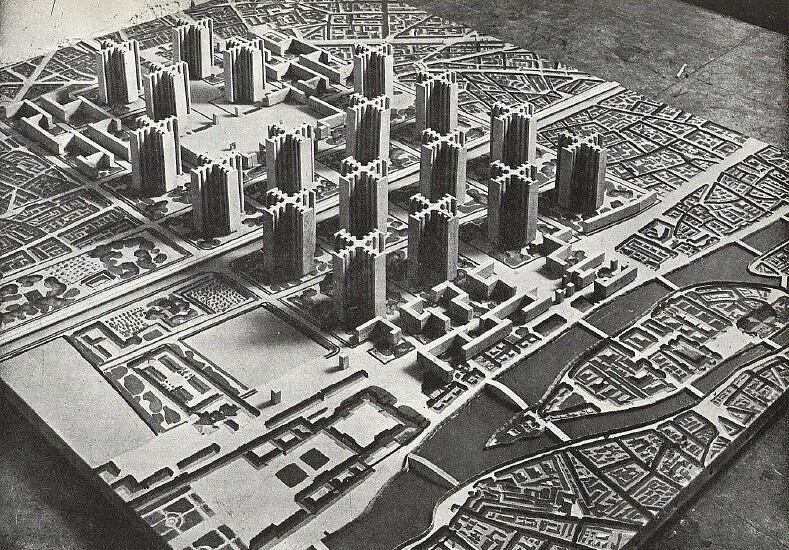
Le Plan Voisin, Le Corbusier, 1922-1925
Through the "pure form" aesthetic style, the uniformity of those urban
structures were made to promote a sense of equality among people. Hence, the
same design model could be applicable everywhere. The means that he
proposed, in the end, were less equal than he thought but let us put
this aside for a second... His aesthetic style did symbolized the new
life.
“ We must create a mass-production state of mind:
A state of mind for building mass-production housing.
A state of mind for living in mass-production housing.
A state of mind for conceiving mass-production housing.”
A state of mind for building mass-production housing.
A state of mind for living in mass-production housing.
A state of mind for conceiving mass-production housing.”
Le Corbusier, Towards a new architecture , 1924
Le Corbusier presented his ideas as universal rules. It was reflected in
his architectural ideas that were said to be easier to reproduce. The
conception of buildings needed to be pre-fabricated, in order to create
the mass-production state of mind. With mass-production manufacturing,
products needed to be easily and quickly reproduced. Therefore
ornamentation was considered as wasted labor. Aesthetic’s criteria were
reduced to abstract geometry, clean lines, and primary colors.
“ The plan must rule… The street must disappear.”
Le Corbusier, Towards a new architecture , 1924
Indeed the street by contrast to a plan is incalculable and
unpredictable. This clear picture of the future is a way to mask the
mess. The new way of life is a universal style, breaking with the
walkways of the past. The new-thinking is the age of standardization,
where everything starts to look like everything else. Mass production
requires mass consumption, but there cannot be mass consumption without
widespread identical ideas.
Cliché, something to start with
Cliché is what has been given to us before to start anything. Clichés are
surely hard to avoid. How would we live or communicate without clichés?
The most original, unique intention must start from a cliché. Something cliché was once specific to a particular time and place. For example, the expression “ Better late than never ” used also in many languages, as in french “ mieux vaut tard que jamais ” has been repeated many times over the centuries. It was first inscribed by the Greek historian Dionysius of Halicarnassus in Romaike Archiologia , “ It is better to be late than to never arrive ”.
Cliché is a variant of the french word cliquer (to click). The term was adopted as printer’s jargon to evoke the clicking sound made by the method of printing from a plate. When the expression has started to be applied generically, its usage was bound up with processes of mechanization, industrialization and with the emergence of print culture enabling the mass circulation of texts. Cliché came also to refer to an ‘image perpetuated without change’, meaning stereotyped and prefabricated. The expression, then, had gained currency in France by the 1860s.
A cliché is an outworn commonplace. It works on a contradiction in the sense that the effect which the cliché had once became blunted with time. It is something so effective that it gets overused to a point where it’s not effective anymore.
In today’s world, with limitless informations and wide cultural productions, a particular thing can become a cliché extremely fast. The unavoidable banalisation of things is what we encounter daily. The battle is to prevent the cliché to happen by compromising it.
The most original, unique intention must start from a cliché. Something cliché was once specific to a particular time and place. For example, the expression “ Better late than never ” used also in many languages, as in french “ mieux vaut tard que jamais ” has been repeated many times over the centuries. It was first inscribed by the Greek historian Dionysius of Halicarnassus in Romaike Archiologia , “ It is better to be late than to never arrive ”.
Cliché is a variant of the french word cliquer (to click). The term was adopted as printer’s jargon to evoke the clicking sound made by the method of printing from a plate. When the expression has started to be applied generically, its usage was bound up with processes of mechanization, industrialization and with the emergence of print culture enabling the mass circulation of texts. Cliché came also to refer to an ‘image perpetuated without change’, meaning stereotyped and prefabricated. The expression, then, had gained currency in France by the 1860s.
A cliché is an outworn commonplace. It works on a contradiction in the sense that the effect which the cliché had once became blunted with time. It is something so effective that it gets overused to a point where it’s not effective anymore.
In today’s world, with limitless informations and wide cultural productions, a particular thing can become a cliché extremely fast. The unavoidable banalisation of things is what we encounter daily. The battle is to prevent the cliché to happen by compromising it.
The Zone of Normalcy
The zone of normalcy represents what is more appealing to lots of
people. It represents cultural products that we see more often.
Everything that lies in the crowd: the mainstream, the ultra popular. It
is the range of products that the public is willing to consider and
accept because it feels reliable enough. Once something becomes too
normalized and overused we consider it obsolete. In opposition, when
it’s irrelevant and difficult to connect with, we call it experimental.
“ Between the zone of normalcy and the zone of experimentation, there is
a sweet spot. Just outside what is considered normal yet familiar enough
to be comprehended, this is where good marketers work. ”
The sweet spot shows us things we’ve never seen before. It’s the
combination of experimental ideas and existing norms creating a
conflicting effect. Something still familiar but slightly controversial.
Something yet difficult to understand but still important. The sweet
spot is the best outcome of normal.
Something novel or innovative can be located within the zone of the sweet spot, but it’s temporary. As time goes, this novelty evolves to become a necessity. Later on, it gets overused and loses its specialness. Its exceptionality becomes commonplace, the product turns into obsolete again.
Surely, the sweet spot reverses the outdated norms and making to counter obsolescence. It’s a blind spot allowing us to look outside of familiarities. Only until strange becomes the new normal. Meanwhile, since the flow of things is constantly shifting, nothing seems really special anymore. Novelty is running out. It appears pointless to seek always what was not there before and it becomes more difficult to recognize anything somehow original. In return, the idea of certain aesthetics being “in” and “out” becomes practically obsolete.
Something novel or innovative can be located within the zone of the sweet spot, but it’s temporary. As time goes, this novelty evolves to become a necessity. Later on, it gets overused and loses its specialness. Its exceptionality becomes commonplace, the product turns into obsolete again.
Surely, the sweet spot reverses the outdated norms and making to counter obsolescence. It’s a blind spot allowing us to look outside of familiarities. Only until strange becomes the new normal. Meanwhile, since the flow of things is constantly shifting, nothing seems really special anymore. Novelty is running out. It appears pointless to seek always what was not there before and it becomes more difficult to recognize anything somehow original. In return, the idea of certain aesthetics being “in” and “out” becomes practically obsolete.
Remix
It’s commonplace to notice a loss of value whenever something enters the
realm of mainstream pop culture.
Tourism is known as an activity frequently motivated by the search of cultural symbols, charged with old-time nostalgia. Uniqueness is the object of the quest. Tourism has triggered a large scale mass production “souvenir” merchandise. Mass production has created the potential for any object to be seen anywhere, which inevitably has an effect on the meaning of things. Mainstream culture and commodity goods present a problem for people who believe in the quality of being unique, special and priceless. Mona Lisa is a typical example of the most mass-produced icon of tourism. It is the must-see cliché of classical art and it’s even known by just being famous. Mona Lisa has not a unique value anymore. Maybe that’s why tourists crowd around the original Mona Lisa, at Musée du Louvre to experience and believe in a way to be in front of uniqueness. Fives centuries after Leonardo da Vinci painted the Mona Lisa, it became an icon of pop culture and has inspired many variations, much more far-reaching today with the internet.
Tourism is known as an activity frequently motivated by the search of cultural symbols, charged with old-time nostalgia. Uniqueness is the object of the quest. Tourism has triggered a large scale mass production “souvenir” merchandise. Mass production has created the potential for any object to be seen anywhere, which inevitably has an effect on the meaning of things. Mainstream culture and commodity goods present a problem for people who believe in the quality of being unique, special and priceless. Mona Lisa is a typical example of the most mass-produced icon of tourism. It is the must-see cliché of classical art and it’s even known by just being famous. Mona Lisa has not a unique value anymore. Maybe that’s why tourists crowd around the original Mona Lisa, at Musée du Louvre to experience and believe in a way to be in front of uniqueness. Fives centuries after Leonardo da Vinci painted the Mona Lisa, it became an icon of pop culture and has inspired many variations, much more far-reaching today with the internet.
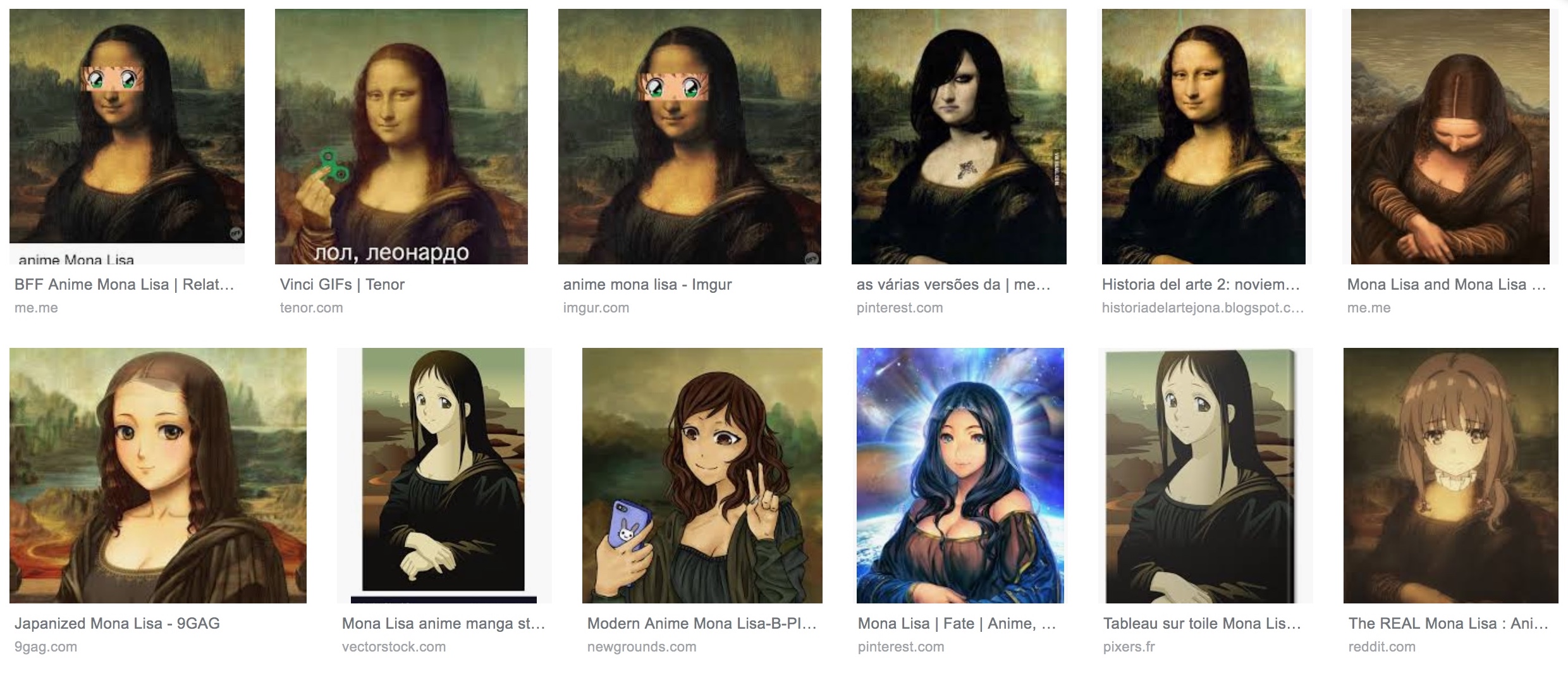
The Internet has enabled everyone to have access to every aesthetic,
therefore the possibility to imitate anything. It greatly increases the
ease of reshaping existing materials from other periods, artists,
designers, music, movies, images… Anything can be remixed.
“ More generally, most human cultures developed by borrowing and
reworking forms and styles from other cultures; the resulting « remixes
» were to be incorporated into other cultures. Ancient Rome remixed
Ancient Greece; Renaissance remixed antiquity; nineteenth century
European architecture remixed many historical periods including the
Renaissance; and today graphic and fashion designers remix together
numerous historical and local cultural forms, from Japanese Manga to
traditional Indian clothing. ”
Nothing starts out original. Any cultural form was probably borrowed in
the first place. Historically, making copies of things was slow and
labor-intensive. Photography altered this traditional creative process
with the instantaneity of a click. Nowadays, new technology has made it
easier and easier to make copies.
Remix tend to be seen as a threat upon self-expression, originality, and intellectual property. Those judgments happened because we are confronted with another logic that speeded up cultural forms. Pretty much anything can be distributed instantly and such accessibility makes anything inevitably quickly copied.
Remix tend to be seen as a threat upon self-expression, originality, and intellectual property. Those judgments happened because we are confronted with another logic that speeded up cultural forms. Pretty much anything can be distributed instantly and such accessibility makes anything inevitably quickly copied.
“ The combination of ubiquitous exposure and the obliteration of
predictable context desensitizes consumers to aesthetic novelty. Just as
aesthetics can no longer truly die, it is now difficult to create an
aesthetic that will be experienced as truly new.”
Overproduction doesn’t go along with the general idea of originality.
For better or worse, the remix is a process based on stolen materials
and has no unique value. Instead, the remix makes appear tipping points
in a continuous thread of recombination and reinterpretation, within the
grey area between homage, collage, and theft.
Take memes for example. Memes of all kinds are always getting new entries or revising old ones by many different people. Within 10 years memes transitioned from this one specific internet subculture to a generic standard in which collective participation is seen as amplifying rather than detracting from value.
Take memes for example. Memes of all kinds are always getting new entries or revising old ones by many different people. Within 10 years memes transitioned from this one specific internet subculture to a generic standard in which collective participation is seen as amplifying rather than detracting from value.
“ Image board memes are arguably the best example of a contemporary
popular mass culture which emerged and developed entirely on the
internet. It is anonymous creations. Other important characteristics of
image board memes are: creations by users, disregard of intellectual
property, viral dissemination among users, and potentially infinite
repurposing and variation (through collage or by changing the text). As
low-resolution images with small file sizes, they can be created and
disseminated instantly, in contrast with the much slower creation,
editing and distribution processes characteristic of traditional
publishing media.”
Memes as Genre: A Structurational Analysis of the Memescape
Overcoming Internet Disillusionment: On the Principles of Meme Design
While imposing uniformity of presentation (rectangular images with
maximum size restraint), it indeed creates productive outcomes.
Genericness is reducing different thoughts to the same standard because
to reproduce the already known is what matters. Memes must be imitated,
remixed and diffused to ensure greater spreadable outcomes. Memes being
anonymous, the publicly shared recognition (going viral, the buzz)
rewards the self-expression with likes, reposts, and hearts.
Overcoming Internet Disillusionment: On the Principles of Meme Design
Today’s culture symbols and value rely heavily on how existing materials are remixed and rendered "new". Although we think remix has the means to make many outcomes, this should not be mistaken with original quest of novelty.
Knock Off
Once a famous brand has been deemed generic, sometimes a brand owner
loses his copyright altogether. Many items we use every day, like
zippers and escalators, were once brand names. Brand names frequently
become generic terms such as Post it, Jet Ski, PowerPoint, Ping Pong,
Kleenex, Chapstick, Jacuzzi and many others. We do not search for
information, we Google it. Not telling we Google something but instead,
we search for it on Google , what would be the justice in that ? Which
of those terms is more original ?
Counterfeit goods and brands is mostly seen as damaging the brand as it violates brand identity property right. It breaks the law by making an exact imitation of something valuable with the intention to deceive or defraud. The country that produces the largest amount of counterfeit is China. Everything can be reproduced to the very last detail: mobile phones, watches, jewelry, branded clothes, and a long etcetera. In a country of fast changes, there’s no better and cheaper way to keep the rhythm with the best and shorten marketing strategies than copying the leaders. Counterfeit products are associated with low quality and low prices. It’s done by using value expressing status the brand delivers. Moreover, counterfeit is no longer limited to a physical product. It has spread to every kind of business, economic activity and services, such as duplicating entire stores’ concept.
Counterfeit goods and brands is mostly seen as damaging the brand as it violates brand identity property right. It breaks the law by making an exact imitation of something valuable with the intention to deceive or defraud. The country that produces the largest amount of counterfeit is China. Everything can be reproduced to the very last detail: mobile phones, watches, jewelry, branded clothes, and a long etcetera. In a country of fast changes, there’s no better and cheaper way to keep the rhythm with the best and shorten marketing strategies than copying the leaders. Counterfeit products are associated with low quality and low prices. It’s done by using value expressing status the brand delivers. Moreover, counterfeit is no longer limited to a physical product. It has spread to every kind of business, economic activity and services, such as duplicating entire stores’ concept.
“ The ritualistic airstrips, offices, military drills, etc. of cargo
cults were an extreme example of authority resemblance, and it
predominates in the design of national flags and many other symbols
(such as commercial brands) that invoke reputation or authority. Where
not tabooed or banned as counterfeiting or trademark violation,
authority resemblance was and is a common feature of innovative
collectibles, their form invoking a traditional authoritative form while
pioneering a new media.”
One particular kind of counterfeit is Knock off. Because the
brand has become so desirable to the public, the brand logo is
repurposed and offered to a broad market. It is not an exact replica. It
partly keeps the connotation of status by slightly or completely
modifying the logo. As we compare it with the original logo, its
deviation shows a brilliant failure. A mark is used to be distinguished
from others. Since Knock off is understood as appropriation,
therefore inevitably it brings unsavory meaning from what the famous
brand intended. This departure from an existing logo leads us to an
impasse. Generally speaking, a mistake designate the opposite of
following rules.
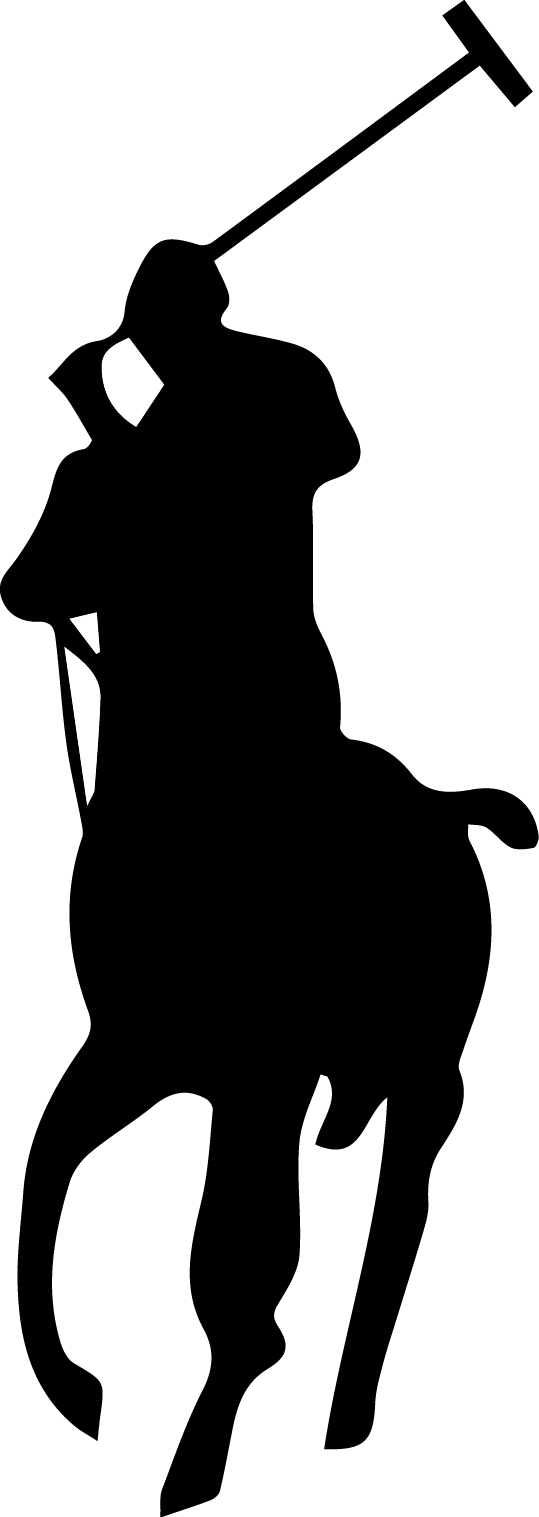





Knock offs will ultimately be destined to be taken as “error”, as it
questions the cultural use of brands. The idea that bootleg clothing
conjures up an image of poorly crafted bag, made from cheap materials,
ripping off design that a luxury brand has created is neither right nor
wrong. Things characterized as failure are not the forgetting of rules
nor the delay of rightness. By departure from authoritative standards,
Knock offs imagine different kinds of potentials.
“ I knocked them up, I didn’t knock them off.”
So if you’re going to knock something off, why not doing it in a classy
way. The Harlem designer, Dapper Dan, opened his shop in 1983 in Harlem,
creating bomber jackets, coats, and suits embossed with logos from
European fashion brands like Louis Vuitton, Fendi, and Gucci. He saw how
people on the rise (hip hop rappers, famous sports players) wanted furs,
diamonds, and fashion symbols. So he found an angle and began to design
coats from rolls of fake logo prints. As his reputation grows, his work
became more exposed to the public and the luxurious fashion houses
started to become aware of his practice. Instead of appreciating the
homage, they sued him for copyright infringement. Confronted with all
this legal pressure, Dapper Dan had no choice than to shut down his
tailoring boutique.
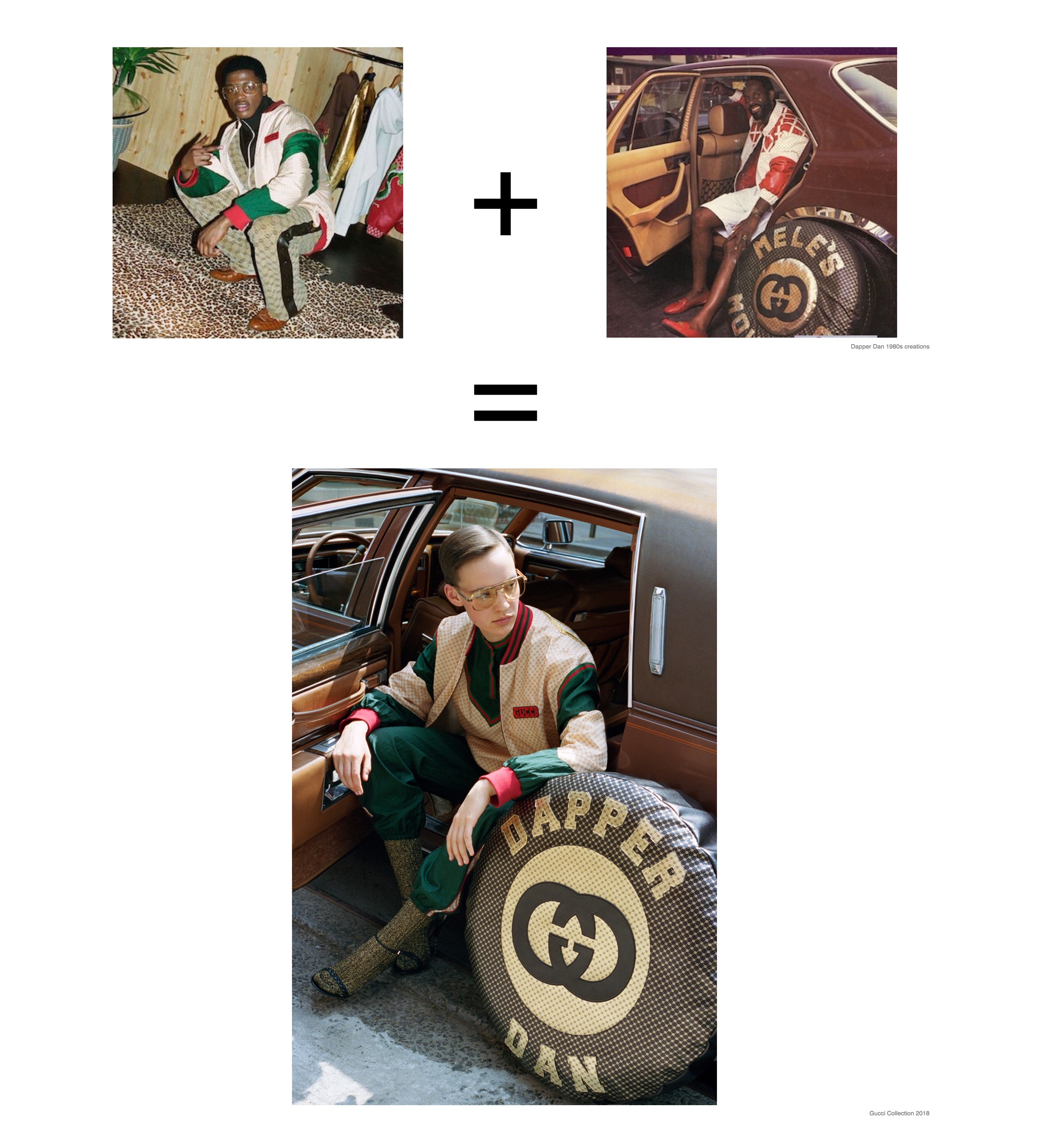
In a surprising turn of events, Dapper Dan now collaborates with Gucci.
The same luxury brand that once sued him, many years later, pays now
homage to Dapper Dan for his designs. The odd thing was by using
self-made fake logo prints, Dapper Dan had taken those luxury brands and
pushed them into something never seen before. At that time, Louis
Vuitton didn’t make clothes at all and Gucci didn’t make clothes with
logos all other them. Moreover, Dapper Dan’s creations sometimes
featured three or four marks mashed-up together into one creation: one
mark as the lining, another from the outside, a third for the lapel, an
a fourth for as pocket squares.
Dapper Dan’s creations were not mistaken with the “original” thing, it was different. He employed the brands in their generic sense, simply identifying with luxury. This is a twisting form of self-expression.
Generally, genericness is resisted because it carries the connotation of conformity, rather than promising singularity. Some brand names like “Vetements” , “Common threads”, “Universal standard” testifies how culture took a different direction where everything has started to look like everything else.
Vetements brand had the fashion industry in its thrall for the last years. People have gravitated towards Vetements because of their elevated basics like jeans made from vintage pairs, oversized jackets, slogan tees and knockoff T-Shirts (DHL’s and Champion’s logos, Metallica’s lightning bolts among many others). The brand’s offbeat look was combined with shows at unconventional locations such as underground sex clubs and Chinese restaurant.
Dapper Dan’s creations were not mistaken with the “original” thing, it was different. He employed the brands in their generic sense, simply identifying with luxury. This is a twisting form of self-expression.
Generally, genericness is resisted because it carries the connotation of conformity, rather than promising singularity. Some brand names like “Vetements” , “Common threads”, “Universal standard” testifies how culture took a different direction where everything has started to look like everything else.
Vetements brand had the fashion industry in its thrall for the last years. People have gravitated towards Vetements because of their elevated basics like jeans made from vintage pairs, oversized jackets, slogan tees and knockoff T-Shirts (DHL’s and Champion’s logos, Metallica’s lightning bolts among many others). The brand’s offbeat look was combined with shows at unconventional locations such as underground sex clubs and Chinese restaurant.
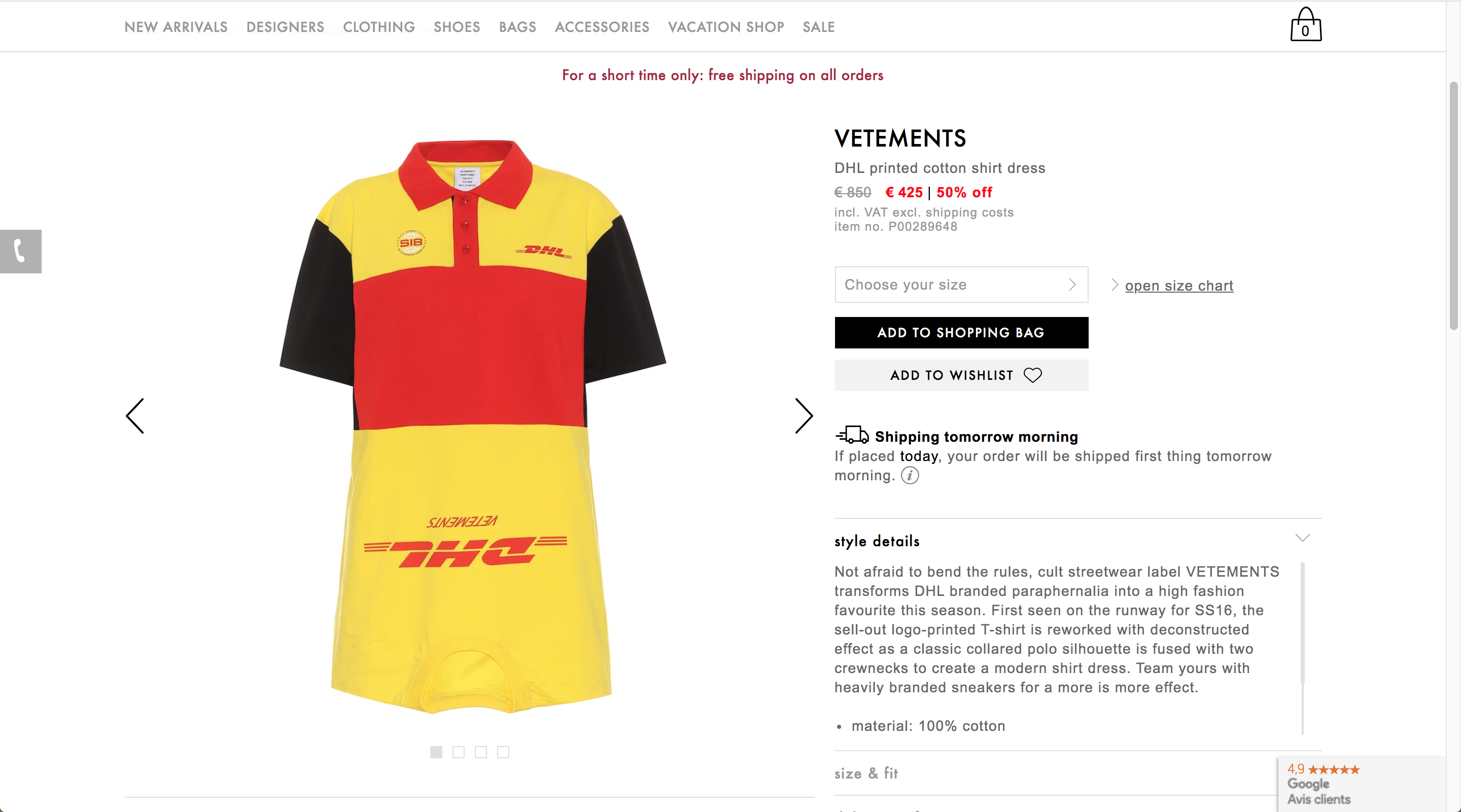
If this DHL T-shirt would not cost 300€, the fashion elite would not
dare wearing it. The distinction is crucial: while the design may be
inspired by counterfeit, a fashionista wearing Vêtements does not
actually want to be mistaken for a lower-life class person. Because a
fashionista needs to believe this T-shirt is more meaningful than a
counterfeit. Because Vêtements need to believe that what they’re
designing is taken a more valuable root than the actual counterfeit in
circulation.
What Vêtements actually seem to have perfected is the act of commodifying a specific anti-attitude, sold to a fashion audience always on the look out for a touch of rebellion in terms of style. Their luxury strategy relies on what we can’t do. What was once judge as forbidden has now turned into a “fashion breakthrough”.
People like associating themselves with things that are transgressive. Being at the edge of what determines what is and isn’t meaningful. Cool people try to be uncool, wearing something expensive that doesn’t look expensive. It seems that the aesthetic of counterfeit offered by Vêtements is perfectly compatible with a fashion industry based on limited stock and high prices, sold back to the fashion elite.
Back to the DHL T-shirt, it’s evident that the line between counterfeit and high fashion has become increasingly blurred. The customer is willing to spend 300€ for a T-shirt branded with the DHL logo because it’s made by a fashion designer rather than just buying it 10€ on Aliexpress. Once we reached this point, no matter which one you wear, this T-shirt shows how genericness has become a niche inside which it’s possible to develop ideas and aesthetics beyond what is typically thought of as “original”.
What Vêtements actually seem to have perfected is the act of commodifying a specific anti-attitude, sold to a fashion audience always on the look out for a touch of rebellion in terms of style. Their luxury strategy relies on what we can’t do. What was once judge as forbidden has now turned into a “fashion breakthrough”.
People like associating themselves with things that are transgressive. Being at the edge of what determines what is and isn’t meaningful. Cool people try to be uncool, wearing something expensive that doesn’t look expensive. It seems that the aesthetic of counterfeit offered by Vêtements is perfectly compatible with a fashion industry based on limited stock and high prices, sold back to the fashion elite.
Back to the DHL T-shirt, it’s evident that the line between counterfeit and high fashion has become increasingly blurred. The customer is willing to spend 300€ for a T-shirt branded with the DHL logo because it’s made by a fashion designer rather than just buying it 10€ on Aliexpress. Once we reached this point, no matter which one you wear, this T-shirt shows how genericness has become a niche inside which it’s possible to develop ideas and aesthetics beyond what is typically thought of as “original”.
What is a parody ?
The parody is a legal form of knock off. The parody needs to mimic an
original to make its point. The parody need to make a joke based on the
original form, or there’s no joke.
The American tv-show, docu-reality comedy series Nathan for You, implies the parody law in the fifth episode “Dumb Starbucks”, which according to Nathan Fielder, “allows you to use trademarks and copyrighted material as long as you’re making fun of them.”
The American tv-show, docu-reality comedy series Nathan for You, implies the parody law in the fifth episode “Dumb Starbucks”, which according to Nathan Fielder, “allows you to use trademarks and copyrighted material as long as you’re making fun of them.”
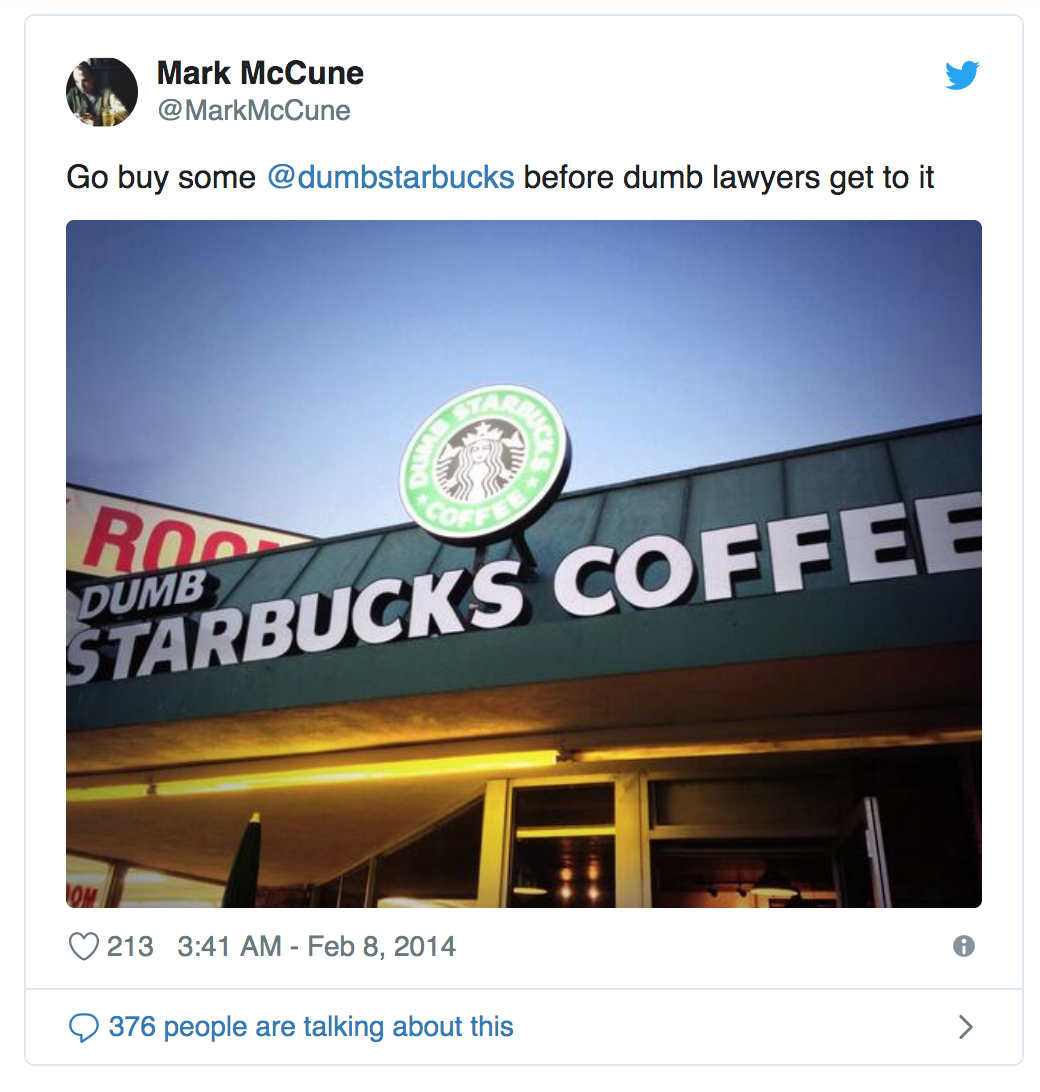
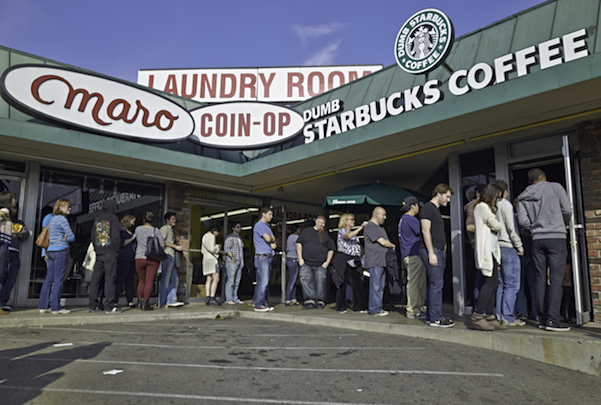
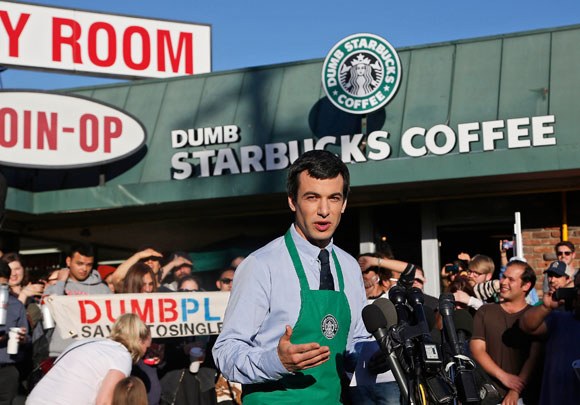
In this show, Nathan Fielder plays an off-kilter version of himself, who
tries to use his business background to offer terrible advice to (real)
small business. In the “Dumb Starbuck” episode, Fielder attempts to help
a struggling coffee shop by renaming it Dumb Starbuck, a strategy to
attract more customers. As parody law permits a fair use of company’s
brands, his idea was to simply appropriate all of Starbucks’ branding
and call it “dumb”.
Legally speaking, unless Nathan Fielder has established himself as a parody artist, “Dumb Starbucks” could not possibly exist because people would confuse it with the real famous coffee chain. Hence, Nathan worked on becoming an established parody artist by writing parodies of classic pop songs to perform at an open mic night. He also organized an art show containing pieces of parody art of well-known corporate logos like Tank of America in lieu of Bank of America.
Now he had the evidence to argue that Dumb Starbucks will be just another one of his art pieces. Under the law, Dumb Starbucks will not be a coffee shop but an art gallery. He posted a craigslist ad searching for baristas with Starbucks experience, and hires two applicants. Dumb Starbucks, finally opens its door in Los Angeles, selling Starbucks products renamed dumb iced vanilla latte, dumb iced cafe mocha… Even the coffee cup sizes were dumb tall, dumb grande and dumb venti.
Within a couple of days, the coffeeshop became a phenomenon, attracting dozens of visitors and provoked real international media coverage. Hundred of people lined up in order to participate in what many thought to believe was a statement against corporations.
This episode has carved out an crazy idea to just make fun of Starbucks. What is even nicer is that no ones were quite sure what it was in the end. Finally, it was only a stupid joke. Overall, it’s an impressive episode of television that creates a mash-up of law, art, commerce and mass media.
Legally speaking, unless Nathan Fielder has established himself as a parody artist, “Dumb Starbucks” could not possibly exist because people would confuse it with the real famous coffee chain. Hence, Nathan worked on becoming an established parody artist by writing parodies of classic pop songs to perform at an open mic night. He also organized an art show containing pieces of parody art of well-known corporate logos like Tank of America in lieu of Bank of America.
Now he had the evidence to argue that Dumb Starbucks will be just another one of his art pieces. Under the law, Dumb Starbucks will not be a coffee shop but an art gallery. He posted a craigslist ad searching for baristas with Starbucks experience, and hires two applicants. Dumb Starbucks, finally opens its door in Los Angeles, selling Starbucks products renamed dumb iced vanilla latte, dumb iced cafe mocha… Even the coffee cup sizes were dumb tall, dumb grande and dumb venti.
Within a couple of days, the coffeeshop became a phenomenon, attracting dozens of visitors and provoked real international media coverage. Hundred of people lined up in order to participate in what many thought to believe was a statement against corporations.
This episode has carved out an crazy idea to just make fun of Starbucks. What is even nicer is that no ones were quite sure what it was in the end. Finally, it was only a stupid joke. Overall, it’s an impressive episode of television that creates a mash-up of law, art, commerce and mass media.
This is Play
Gregory Bateson, an English anthropologist explored social behaviors
through different types of communication. He articulated a theory about
meta-communication while observing monkeys playing at the San Francisco
Zoo. He discovered the paradox nature of play, taking the example of two
monkeys playing. In the game, two monkeys perform acts which stand for
fighting. Yet, those playful actions are very similar to fighting, but
looking closer there are not really fighting. The game is not
aggressive, it's playful. This is a “non-fight”.
“Now this phenomenon, play, could only occur if the participant
organisms were capable of some degree of meta-communication, of
exchanging signals which could carry the message ‘this is play’. ”
Gregory Bateson, A Theory of Play and Fantasy , 1955
Perhaps a peculiar quality emerges in this kind of duality, splitting,
doubling, reversal, tension… Any play is a form of resistance. Argument
or fighting, in its simplest form, is a game: “I say Yes, you say No”.
Or just any game like basketball or soccer ‘ I try to make a goal, you
try to stop me’. Even a sophisticated game like chess, it’s all about
winning or losing in the end.
“What people enjoy is not the sense of being in control, but exercising
control in difficult situations… Enjoyment appears at the boundary
between boredom and anxiety, when the challenges are just balanced with
the person’s capacity to act.”
Mihaly Csikszentmihalyi, Psychologist
Voir les pots de fleur à l'envers
* as if the world is turned upside down
How do we get to the place where
someone’s certain desire to be creative is in tension with the desire to
belong. Duality does both things simultaneously, bringing together
conflicting aspects. If you are disposed to use risky approaches and to
destabilize the way things are, the chances of losing are most certainly
increased. But being predictable is usually a bad thing because it means
you can be mistreated by your adversary. This dilemma proves the
importance to make things stronger and more fulfilling.
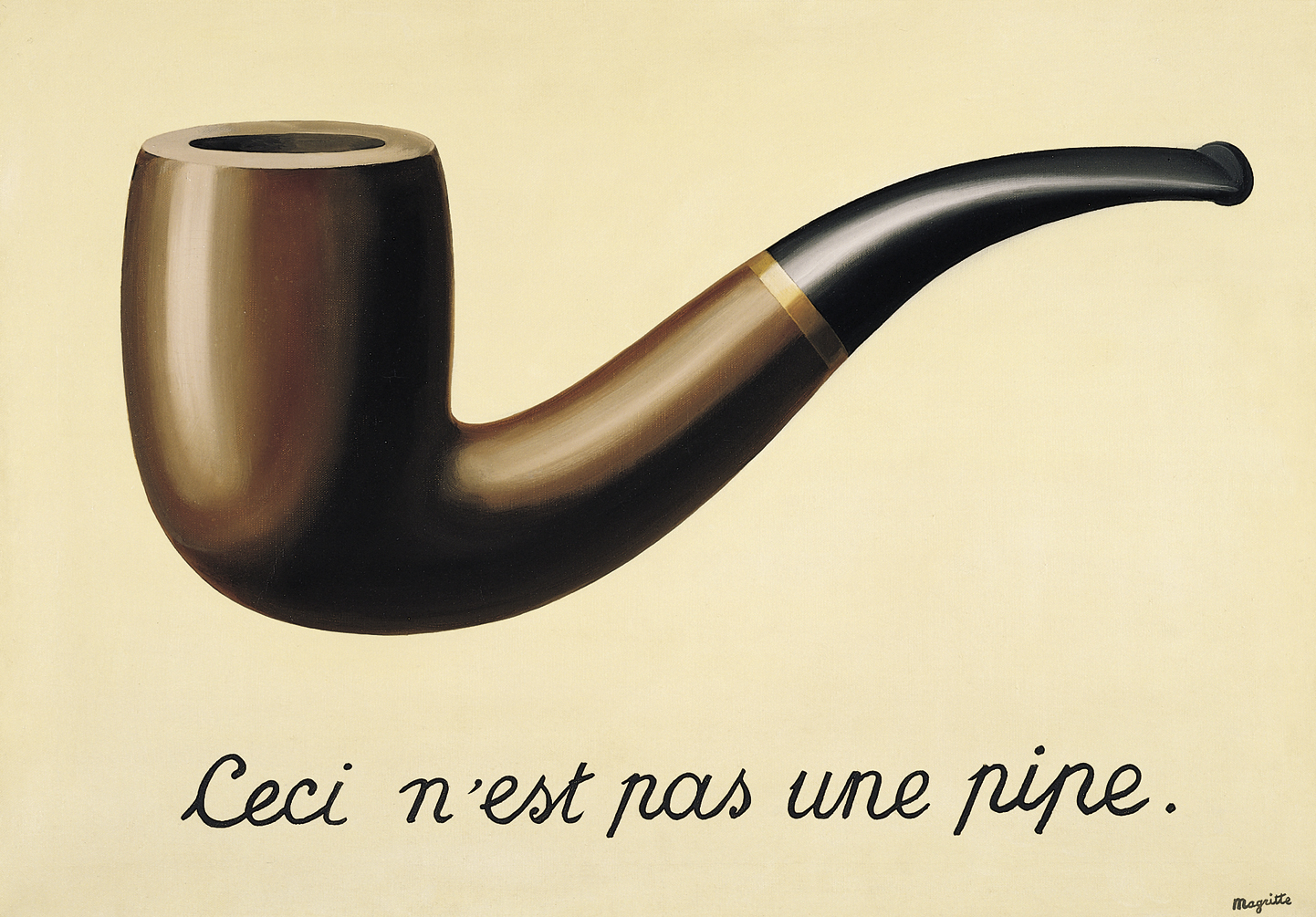
La trahison des images (The treachery of images), René Magritte, 1929
Why designate the pipe “ this is not ” rather than “ this is”? What’s wrong with this painting?
René Magritte is really indifferent to the viewer logic. He’s pushing the art of manipulating images and words. He disturbs us, images, words...
The “reality” of the pipe is all very realistic. Without the slightest hesitation, we recognize a pipe. However, the straightforward representation is somehow disoriented. Even if the pipe should find its right place, a disturbing effect remains and prevents the image and words of becoming straight-fully perfect.
The relationship “ It is / it is not ” goes in both direction at once, it is a nonsense. Everything is pointless. Everything is nothing with a twist. This is an aestheticized paradox. It suggests that if we want to go off the grid, drop out and switch things off, then we should fight the range of accepted thought.
René Magritte is really indifferent to the viewer logic. He’s pushing the art of manipulating images and words. He disturbs us, images, words...
The “reality” of the pipe is all very realistic. Without the slightest hesitation, we recognize a pipe. However, the straightforward representation is somehow disoriented. Even if the pipe should find its right place, a disturbing effect remains and prevents the image and words of becoming straight-fully perfect.
The relationship “ It is / it is not ” goes in both direction at once, it is a nonsense. Everything is pointless. Everything is nothing with a twist. This is an aestheticized paradox. It suggests that if we want to go off the grid, drop out and switch things off, then we should fight the range of accepted thought.
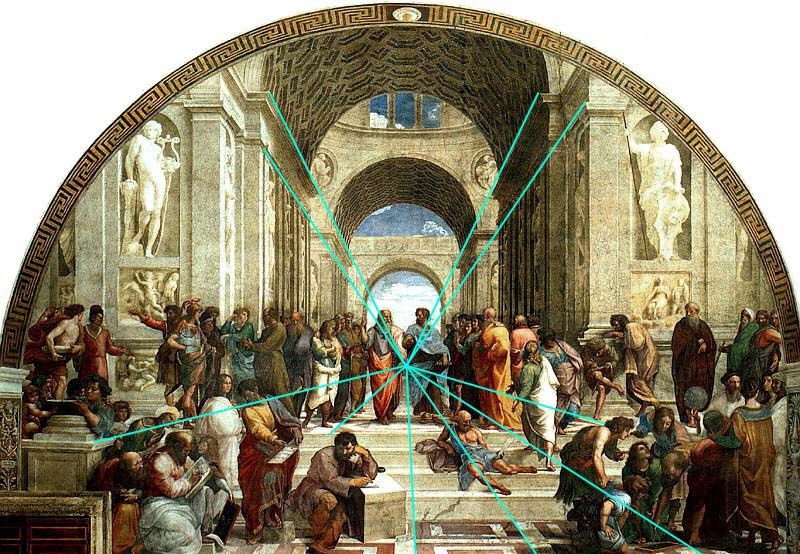
Way back in the Renaissance period, the perspective became a successful
system of representation. Before to call it “perspective”, it was
“commensuratio”. It meant that the world became measurable to mankind.
“Man is the measure of all things” said Protagoras.
Perspective was not a single thing but a combination of elements that extended as far as art, geometry, mathematics and scientific instruments. Art and science wanted to create a rational framework into mathematical, geometrical ordered and limited space. At the same period, territories was measured in cartography and time was measured thru the mechanical clock. The perspective model was meant to build an ideal proportion, ordered and harmonious vision of the world. Greatly representing the visible world as realistic as perfect and beautiful as possible.
Perspective was not a single thing but a combination of elements that extended as far as art, geometry, mathematics and scientific instruments. Art and science wanted to create a rational framework into mathematical, geometrical ordered and limited space. At the same period, territories was measured in cartography and time was measured thru the mechanical clock. The perspective model was meant to build an ideal proportion, ordered and harmonious vision of the world. Greatly representing the visible world as realistic as perfect and beautiful as possible.
Perspective and Distortion as Modes of Representation of Power and
Rebellion in D.H Lawrence’s “ Introduction to these paintings”,
Brigittte Macadré
The magic circle: Embraced
However, some deviations of the perspective model started to evolve in
the 15th century. Dealing with geometrical issues, the renaissance
painter Piero Della Francesca pointed out the fact that sometimes
distortion of objects (anamorphosis, foreshortening) will appear while
following laws of mathematics. These discoveries became a comment about
limits of perspective.
The magic circle: Embraced
While the perspective was recognized as a powerful model, some artists (like Piero Della Francesca, Andrea Mantegna, Leonardo Da Vinci) were enticed by a form of perspective that was aimed to produce a mystery.
How to represent the unrepresentable?
What cannot be seen should be figured with a clever insight: the distortion of perspective.

Piero della Francesca, the Annunciation, Polyptich of Perugia, 1460/70
The Annunciation is a great story to question the limits of
perspective’s laws. Whatever is worth measuring the world, there are
aspects of reality we can’t measure.
In The Annunciation of Piero Della Francesca, the classical perspective’s laws of the “measurable” are combined with intern discrete distortion to express “ the immeasurable”. The distortion is used to figure a moment impossible to represent.
Angel Gabriel is on the left side, Mary on the right side. Between both, a corridor with a very long perspective of colonnades. Above this corridor “the divine light” appears symbolized by the dove. The distortion is not immediately apparent, it is subtly hidden, waiting to be recognized. If we look closer, there is indeed something hidden. The corridor between both of them is actually longer than it should be.
A column hides Mary. If Gabriel raises his eyes, it is not Mary he sees, but a massive column. Moreover, Piero Della Francesca intensifies the distortion by placing a marble slab at the end of the corridor which almost breaks the effect of perspective that he has created with the colonnades of the corridor, as if the marble slab was nearby on the front.
Why a composition so realistic in appearance had to produce so many “mistakes”?
A mistake relies on the incalculable, the indemonstrable, the imperfect. It is clear that Piero Della Francesca intentionally wanted to build a non-rigorous representation to attract viewer attention by using intern distortion. In a representation pushed to perfection, imperfection will stand out. Many subtle rules have created this painting, seemingly limpid and clear, but revealing itself at the end as an ambiguous image: the reverse perspective of the perspective.
Perspective is symbolically imposing an idealized viewpoint of reality over any other. Therefore, it’s worth reconsidering its self-evident character. Distortion is showing an “off-stage” side of the perspective by strategically highlighting its intern limitations. It intentionally reveals perspective’s paradoxical nature: the world is available to us geometrically and mathematically, but only in so far as we embrace the illusions through which this reality is conveyed.
Distortion is drawn according to the laws of perspective. Therefore perspective’s laws are disturbed, but not too much. At least objects, space, and stories don’t loose their evident clarity. Because we do love convention and things reduced to a norm, limits of any exploration are always restored through a clearly pointed viewpoint.
In The Annunciation of Piero Della Francesca, the classical perspective’s laws of the “measurable” are combined with intern discrete distortion to express “ the immeasurable”. The distortion is used to figure a moment impossible to represent.
Angel Gabriel is on the left side, Mary on the right side. Between both, a corridor with a very long perspective of colonnades. Above this corridor “the divine light” appears symbolized by the dove. The distortion is not immediately apparent, it is subtly hidden, waiting to be recognized. If we look closer, there is indeed something hidden. The corridor between both of them is actually longer than it should be.
A column hides Mary. If Gabriel raises his eyes, it is not Mary he sees, but a massive column. Moreover, Piero Della Francesca intensifies the distortion by placing a marble slab at the end of the corridor which almost breaks the effect of perspective that he has created with the colonnades of the corridor, as if the marble slab was nearby on the front.
Why a composition so realistic in appearance had to produce so many “mistakes”?
A mistake relies on the incalculable, the indemonstrable, the imperfect. It is clear that Piero Della Francesca intentionally wanted to build a non-rigorous representation to attract viewer attention by using intern distortion. In a representation pushed to perfection, imperfection will stand out. Many subtle rules have created this painting, seemingly limpid and clear, but revealing itself at the end as an ambiguous image: the reverse perspective of the perspective.
Perspective is symbolically imposing an idealized viewpoint of reality over any other. Therefore, it’s worth reconsidering its self-evident character. Distortion is showing an “off-stage” side of the perspective by strategically highlighting its intern limitations. It intentionally reveals perspective’s paradoxical nature: the world is available to us geometrically and mathematically, but only in so far as we embrace the illusions through which this reality is conveyed.
Distortion is drawn according to the laws of perspective. Therefore perspective’s laws are disturbed, but not too much. At least objects, space, and stories don’t loose their evident clarity. Because we do love convention and things reduced to a norm, limits of any exploration are always restored through a clearly pointed viewpoint.
Conclusion
Endlessly making the same gesture is either boring or fascinating. What
if cultural production is currently tied up to a particular power:
normalization. Normalization is in a way, a general instrument that can
be found everywhere and generally accepted. As much as they materialize
an ephemeral devoid of meaning, standards and norms play a critical role
to determine through which new forms may come forth. It shapes our
values, behaviors and lifes.
Crossroads of aesthetics, norms, and cultures are a messy business. We live among variety, but as if there’s nothing worth the price anymore, it feels like an exhausting meaningless fatigue. New trend and approaches are endlessly spread like wildfire to extinguish what existed before. Cultural production just renews itself for no particular reason other than to provide something else for us to consume. The production of the new is bound to struggle in a system in which everything is visible, accessible, and normalized.
In order to understand obsolescence, it is thus important to purchase wider concerns about cultural banality of mass consumerism. The remix is still somehow an obscure mode of production that makes us realize that culture can be indefinitely malleable and it requires to cultivate a capacity to adapt to any situation. At time goes, the generic and the unique exists at the same time.
The question of limits is useful to understand the process of product cycle. In a society pushed to automation, de-automation will stand out. The common strategy deployed in the creation of the new is to playfully battle existing norms. Thankfully, the margins of cultural production exist, otherwise the world will be so boring and sad...
All opposition meets somewhere in the middle. If everything has its opposite, Its because culture production used this logic to communicate and reproduce values. Looking at what often been thought as duality, it is just a football field willing to negotiate different realities that otherwise we avoid or are estranged from.
Why cultural production has to repeat the cliché of "Rule-Breaking"?
As to prevent aesthetic forms (styles) of coming to an end, keeping everything in play is a ruse to resist in order to prove that we exist."Rule-Breaking" looks forward, but unfortunately (or not) most of the time, doing something wrong is seen as unnecessary when it contredicts the notion of quality. Almost doing wrong is about the necessity not to find a timeless meaning, but to repeat an ongoing play in which images will require constant powerful statements.
Crossroads of aesthetics, norms, and cultures are a messy business. We live among variety, but as if there’s nothing worth the price anymore, it feels like an exhausting meaningless fatigue. New trend and approaches are endlessly spread like wildfire to extinguish what existed before. Cultural production just renews itself for no particular reason other than to provide something else for us to consume. The production of the new is bound to struggle in a system in which everything is visible, accessible, and normalized.
In order to understand obsolescence, it is thus important to purchase wider concerns about cultural banality of mass consumerism. The remix is still somehow an obscure mode of production that makes us realize that culture can be indefinitely malleable and it requires to cultivate a capacity to adapt to any situation. At time goes, the generic and the unique exists at the same time.
The question of limits is useful to understand the process of product cycle. In a society pushed to automation, de-automation will stand out. The common strategy deployed in the creation of the new is to playfully battle existing norms. Thankfully, the margins of cultural production exist, otherwise the world will be so boring and sad...
All opposition meets somewhere in the middle. If everything has its opposite, Its because culture production used this logic to communicate and reproduce values. Looking at what often been thought as duality, it is just a football field willing to negotiate different realities that otherwise we avoid or are estranged from.
Why cultural production has to repeat the cliché of "Rule-Breaking"?
As to prevent aesthetic forms (styles) of coming to an end, keeping everything in play is a ruse to resist in order to prove that we exist."Rule-Breaking" looks forward, but unfortunately (or not) most of the time, doing something wrong is seen as unnecessary when it contredicts the notion of quality. Almost doing wrong is about the necessity not to find a timeless meaning, but to repeat an ongoing play in which images will require constant powerful statements.
